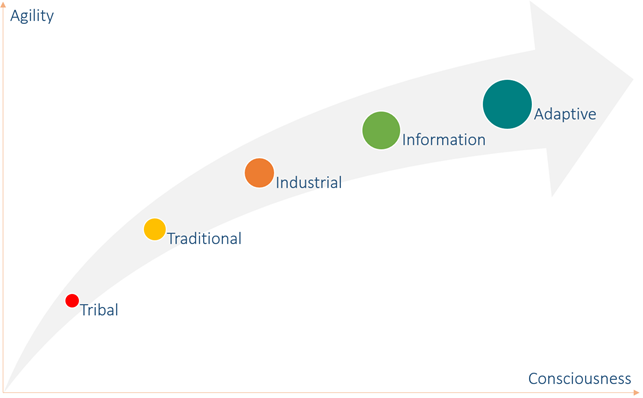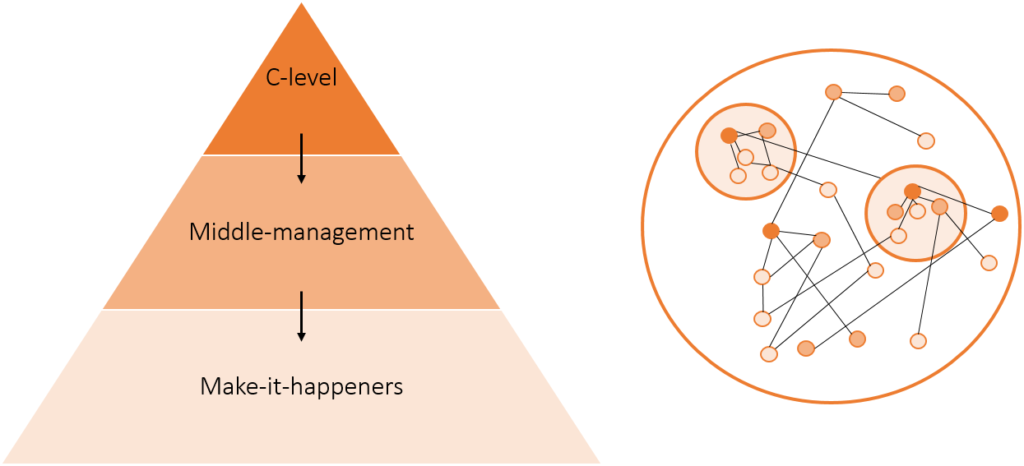I’ve recently attended Agile events where world-class gurus state that Scrum is broken, the Product Owner is a waste, or LESs is better than SAFe. Tools are built for a purpose. You can use a tool for a certain purpose only in a certain context. When the context evolves, the tools also need to evolve.
What does not change, are the underlying principles. Misuse of a tool is easy if you don’t understand the principles. There are tons of studies regarding ScrumBut, where the Scrum tool is abused. Where the (Agile) principles are not followed, even if the (Scrum) tool is in use.
Maturity of the organisation defines the context
According to Reinventing Organizations by Laloux, in today’s predominant organizational model the leader in the hierarchy turns a cog that directs the workers below. Planning and execution are strictly separated. This leads to silos, rigidity, no innovation, no responsibility, no ability to advance meaningfully in the career. Laloux divides cognitive, psychological and moral maturity into five levels*. Higher levels build on top of the lower ones.
| Name | Description | Examples |
|---|---|---|
| Tribal – “Red” | A simple hierarchy to steer work and a wolf-pack mentality | Mafia and Startups |
| Agrarian – “Traditional” | Large organizations with numerous roles and steering mechanisms, like long and medium-term planning. Planning and execution are strictly separated. Control what and how. Thinking happens at the top, doing at the bottom. The underlying worldview is that workers are mostly lazy, dishonest, and in need of direction. | Church, military and government |
| Industrial – “Orange” | Profit and growth are the most important measurements. Achieved by the means of innovation, accountability and meritocracy. RnD, Marketing and Product Management departments are invented. Control what. The underlying worldview is based on material success. | Multinational companies |
| Information – “Green” | Focus on culture and empowerment to achieve high employee motivation. Highly sensitive to people’s feelings. All the perspectives deserve equal respect. Where Industrial level seeks to make decisions top-down, based on objective facts, expert input and simulations, Information level strives for bottom-up processes. Information level brings opposing points of view to eventual consensus. Where Industrial level views organizations as machines, the dominant metaphor of organizations in Information level is the family. It seeks fairness, equality, harmony, community, cooperation, and consensus. | Culture-driven organizations |
| Adaptive – “Teal” | “Post-postmodern consciousness”. No bosses, no competition. In this mindset, ego is viewed from a distance. We can see ego’s fears, ambitions, and desires: In the Tribal level, a good decision is the one that gets me what I want. In the Traditional level, decisions are determined by social norms of what is right and wrong. In the Industrial level, effectiveness and success are the yardsticks. In Information, matters are judged by the criteria of belonging and harmony. We use measures of inner rightness: Does this decision seem right? Am I being of service to the world? | Network organizations |
Summary of Laloux’s levels of organizational development. The names and colour codes come from Lalouxs’ book, however, they were different in the original work of Beck and Wilber.

Both consciousness and adaptability grows with the maturity of the organization
Self-organising
According toLaloux, in the highest level of maturity (“Adaptive”) we don’t pursue recognition, success or wealth. We pursue a life well lived. Still, the consequence might be recognition, success, wealth, or love. Adaptive organizations reveal three major breakthroughs: evolutionary purpose, wholeness, and self-management. These major breakthroughs make organizations prosper given the right context. Companies like Buurtzorg, Patagonia or Zappos show strengths of the Adaptive level:
- Employees thrive
- Salaries above market rates
- Grow year in, year out
- Achieve remarkable profit margins
Adaptive level brings three organizational breakthroughs:
- Principles driven decision making. Rather than trying to predict and control, Adaptive organizations try to sense and respond. Similarly, as the Cynefin framework describes working process in the complex environment, that consist of “unknown” factors. The output cannot be planned predicted, but one must proceed with principles driven decision making in an environment where it is safe to fail. Like Stephen Covey says “There are three constants in life: Change, choice and principles”.
- Wholeness creates an environment of safe conversations. Safe conversations invite deep listening, authenticity and vulnerability. It is assumed that everyone seeks for the common benefit, even if their opinions seem different. Conflicts are dealt with understanding. This will create smarter networks, unleash creativity and bring higher employee satisfaction. Like Douglas Stone says “The urge to blame is based.. on the fear of being blamed.”
- Minimum Viable Management does not mean a free-for-all. It means form-follows-need: Roles are picked up, discarded, and exchanged fluidly. Power is distributed. Decisions are made at the point of origin. Innovations can spring up from all quarters. Meetings are held when they are needed. Temporary task forces are created spontaneously and quickly disbanded again. The leaders of self-managing organizations feel, that it is less risky to deploy self-managed teams. That self-managed teams make better decisions. Like Bruce Lee stated “It’s not the daily increase but daily decrease. Hack away at the unessential.”
These three principles enable the organization to better handle uncertainty, complexity and magnitude of nowadays Agile business. Adaptive organisation work efficiently and fast, while fewer power games and egoism is in the way of creativity. More effort is used on improving individuals and organizations.
Where to start
Team of Teams by McChrystal underlines the idea of creating nimble, transparent, and horizontal organizations. Organizations which empower their people to execute based on the concept of ‘shared consciousness’. People are empowered to trust their gut and use their best judgement based on their training and knowledge of organizational goals. The book gives good ideas of
- Break down organizational silos by sending liaisons to other teams
- Empower everyone to make decisions, don’t act as a decision bottleneck
- Hold frequent sync up meetings to disseminate information
- Set up cross-disciplinary open-plan workspaces
- Enable people to make decisions at lower in the hierarchy and get to know their counterparts in other teams
- Be a gardener. Plant and provide water and nutrients. No heroic micromanagement
- Monitor data and real-time information, but stay away from control-freak and micromanagement.

From hierarchy to networks (Team of Teams way of drawing the idea)
Need for speed
Holacracy by Robertson also seeks for knowledge economy replacement for the command-and-control organization. Robertson quotes Elliott Jaques who identified three types of organization structures:
- Formal: the official organizational chart and the job descriptions
- Extant: how things actually work and who really makes decisions
- Requisite: a setup that would be most natural and best suited to the work and purpose of the organization.
The Idea of The Holacracy is to achieve the requisite organizational structure. Holacracy’s systems and processes are about helping the organization find its own unique identity and structure. In Holacracy, a pyramidal hierarchy is replaced with “circles” dedicated to specific functions. Each of the circles has a “lead” who, like a traditional manager, is responsible for assigning work and seeing that it’s completed. They, however, are not responsible for determining how the work is done. A kind of company-level crowd-sourcing.

From hierarchy to networks (Holacracy way of drawing the idea)
Fit for purpose
There are no good or bad ways to organize. The question remains whether the structure is a good fit for the task at hand. Mature levels are better suited for the purpose of more sophisticated work, with high complexity and high skill set. And lower levels are better suited for crisis situations. The organizations are far from consistent and are a mix of both. The maturity of an organization is influenced by the context and by the leader of the organization.
Back to Scrum
Scrum is not an absolute value. Just a tool. Originally Scrum was a counterattack to Waterfall. From fixed scope to work decomposition, fast feedback, retrospectives and being close to the customer. The idea of Agile is to create high value to the customer by means of collaboration, demos, improvement and being open to change.
In this context Scrum is a process to take an organization to the next level of maturity. Scrum gives the management a feeling of top-down control by managing the product backlog. Simultaneously Scrum provides the team with a freedom and safety to make bottom-up decisions. At some point, there is no more need for the safety provided by the hierarchical Scrum mechanism. Similarly, you may evolve from component teams to feature teams.
What makes the tools like Scrum, Kanban or SAFe work are the underlying principles like
- Agile (https://gofore.com/agile-transformation-action-part-1/ )
- Lean (https://en.wikipedia.org/wiki/Toyota_Production_System )
- Systems Thinking (https://gofore.com/en/what-is-systems-thinking-and-how-should-i-use-it/)
- Cynefin (https://en.wikipedia.org/wiki/Cynefin_framework)
Agile is about adapting to an unclear situation by using regular feedback loops and prioritization. Lean is about regular retrospectives and improving the ways of working. Systems Thinking and Cynefin teach about system dynamics and how to operate them.
Summary
Keep the principles in mind and use them as your guiding force. Build on strengths and potential. Understand the context where you operate. Each context presents different dynamics. Keep in mind the ‘fit-for-purpose’ of each tool. Any tool can be abused if it is used following the wrong principles. Consequences are governed by principles, not by the tools. Therefore, value principles.
* The evolutionary model presented comes originally from Don Beck, whose work was borrowed by Ken Wilber.



